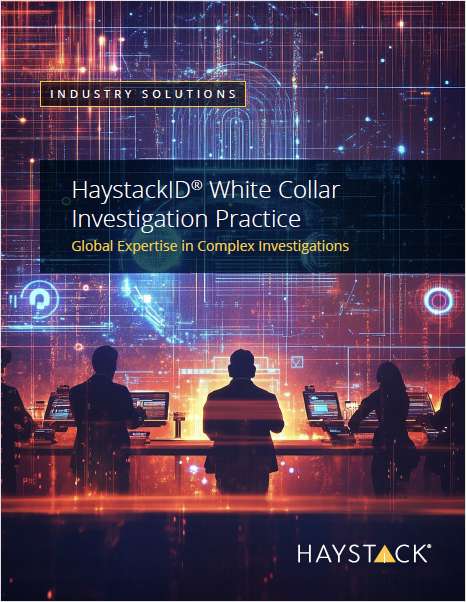Federal Judges Worried Most About Ephemeral Messages' Effect on E-Discovery
According to Exterro's 2020 Judges Survey, the view from the bench is that ephemeral messaging apps, along with privacy laws and the wide number of potential data sources, are likely to inhibit attorneys' ability to bring more organization to the e-discovery process.
January 28, 2020 at 02:48 PM
5 minute read
The original version of this story was published on Legal Tech News

E-discovery headaches aren't just for lawyers anymore. Today, Exterro released its 2020 Judges Survey in a collaboration with EDRM and Georgetown Law Continuing Legal Education, and respondents pointed to some critical issues with the collection and preservation of electronic data that can't be dismissed with a gavel.
The survey cultivated responses from 20 U.S. federal district and magistrate judges, with the general takeaway being that those sitting behind the bench would like to see attorneys from both sides get the majority of their e-discovery issues sorted out sooner rather than later. But technology may continue to be both a help and a hindrance to those efforts, with ephemeral messaging apps like Snapchat and other emerging media continuing to throw a wrench into the proceedings.
For example, respondents were asked what new data type legal teams should be most worried about in the next five years, with close to 70% indicating ephemeral apps. Biometric data followed far behind at about 15%, trailed by text messages and mobile data at nearly 5%. Meanwhile, traditional social media garnered none of the vote.
Ron Rambo, a content manager at Exterro, attributed traditional social media's lack of a presence to the possibility that folks may have largely become used to or comfortable with those mediums. Ephemeral messaging apps, however, are still relatively new—meaning so are the collection and preservation tools that e-discovery providers are developing to address that type of data. In other words, it may be a problem that's low on solutions.
"I don't know that you're going to get any involvement from Snapchat or any involvement from WhatsApp. It doesn't seem like they are very interested or they really care about the legal space when it comes to this stuff. … I think that their whole thing is user first, and everyone else has to catch up," Rambo said.
But tools geared towards ephemeral messaging could play a role in the future of e-discovery solutions providers.
"My expectation will be that to the degree that the courts rule that ephemeral messaging needs to be preserved and protected, then the technology companies will come together to figure out a way to make that happen," said Bill Piwonka, chief marketing officer at Exterro.
Still, even more familiar technologies or communications platforms can still pose issues to the e-discovery process. Respondents were asked what types of data they had seen spoliated most often over the last 12 months, and the majority (about 55%) appeared evenly split between social media and text messages or mobile data. Email came in third at close to 45% of respondents.
In this case, the obstacle that legal teams are encountering may not be a lack of technology, but the sheer volume of ground they have to cover in order to locate and successfully preserve certain pieces of electronic information. Rambo referenced an order issued earlier this month by a Massachusetts Superior Court Justice requiring Facebook to turn over information related to thousands of apps the platform had suspected of misusing user data.
"I couldn't tell you how many [apps] I have on my Facebook. And if they have your data, the third parties have your data, and Facebook isn't keeping track of what data the third parties have, then they are not paying attention to your data either, so it could be anywhere," Rambo said.
But the e-discovery process doesn't necessarily become any easier—or cheaper—once a piece of data is located. Respondents were asked to judge the veracity of the sentiment that privacy laws in the vain of the General Data Protection Regulation and California Consumer Privacy Act would make e-discovery practices more expensive. The majority of respondents (just over 75%) answered "true."
The evidence backing that conclusion may range from the difficulties entities face in trying to comply with legal holds or cross-border e-discovery demands without triggering any privacy laws.
Per Rambo, tech solutions will continue to reflect the greater convergence between privacy and e-discovery. "That's one unified platform that gets you from point A to point B… All of your e-discovery needs to your privacy compliance, your information governance, data inventory management, all that stuff," Rambo said.
However, there are still some targets that tech may not be ready to hit. When asked what e-discovery technology they would like to see legal teams using more, the majority of respondents (near 70%) pointed to early case assessment tools that afford users the ability to quickly identify and review responsive data prior to collection.
Rambo indicated that AI might be a key player in that endeavor, but the technology's accuracy rate needs to improve first.
"The struggle right now, I think for a lot of companies, is just getting the AI right," Rambo said.
While technology may still be evolving, attorney knowledge and expertise in e-discovery appears to have stayed about the same, with only 15% of judges agreeing that e-discovery competence has gotten worse compared with last year's 18%. Piwonka expects the e-discovery proficiency rate among attorneys to continue to improve.
"Now we've got a whole generation of digital native people, so the attorneys that are coming on now, not only do they have strengths in the traditional areas of the more liberal arts, but they also are just much more comfortable with technology because it's been part of their lives since it's been born," Piwonka said.
This article has been updated with comment from Exterro CMO Bill Piwonka.
This content has been archived. It is available through our partners, LexisNexis® and Bloomberg Law.
To view this content, please continue to their sites.
Not a Lexis Subscriber?
Subscribe Now
Not a Bloomberg Law Subscriber?
Subscribe Now
NOT FOR REPRINT
© 2024 ALM Global, LLC, All Rights Reserved. Request academic re-use from www.copyright.com. All other uses, submit a request to [email protected]. For more information visit Asset & Logo Licensing.
You Might Like
View All

Florida-Based Law Firms Start to Lag, As New York Takes a Bigger Piece of Deals
3 minute read

European, US Litigation Funding Experts Look for Commonalities at NYU Event
Trending Stories
- 1Gibson Dunn Sued By Crypto Client After Lateral Hire Causes Conflict of Interest
- 2Trump's Solicitor General Expected to 'Flip' Prelogar's Positions at Supreme Court
- 3Pharmacy Lawyers See Promise in NY Regulator's Curbs on PBM Industry
- 4Outgoing USPTO Director Kathi Vidal: ‘We All Want the Country to Be in a Better Place’
- 5Supreme Court Will Review Constitutionality Of FCC's Universal Service Fund
Who Got The Work
Michael G. Bongiorno, Andrew Scott Dulberg and Elizabeth E. Driscoll from Wilmer Cutler Pickering Hale and Dorr have stepped in to represent Symbotic Inc., an A.I.-enabled technology platform that focuses on increasing supply chain efficiency, and other defendants in a pending shareholder derivative lawsuit. The case, filed Oct. 2 in Massachusetts District Court by the Brown Law Firm on behalf of Stephen Austen, accuses certain officers and directors of misleading investors in regard to Symbotic's potential for margin growth by failing to disclose that the company was not equipped to timely deploy its systems or manage expenses through project delays. The case, assigned to U.S. District Judge Nathaniel M. Gorton, is 1:24-cv-12522, Austen v. Cohen et al.
Who Got The Work
Edmund Polubinski and Marie Killmond of Davis Polk & Wardwell have entered appearances for data platform software development company MongoDB and other defendants in a pending shareholder derivative lawsuit. The action, filed Oct. 7 in New York Southern District Court by the Brown Law Firm, accuses the company's directors and/or officers of falsely expressing confidence in the company’s restructuring of its sales incentive plan and downplaying the severity of decreases in its upfront commitments. The case is 1:24-cv-07594, Roy v. Ittycheria et al.
Who Got The Work
Amy O. Bruchs and Kurt F. Ellison of Michael Best & Friedrich have entered appearances for Epic Systems Corp. in a pending employment discrimination lawsuit. The suit was filed Sept. 7 in Wisconsin Western District Court by Levine Eisberner LLC and Siri & Glimstad on behalf of a project manager who claims that he was wrongfully terminated after applying for a religious exemption to the defendant's COVID-19 vaccine mandate. The case, assigned to U.S. Magistrate Judge Anita Marie Boor, is 3:24-cv-00630, Secker, Nathan v. Epic Systems Corporation.
Who Got The Work
David X. Sullivan, Thomas J. Finn and Gregory A. Hall from McCarter & English have entered appearances for Sunrun Installation Services in a pending civil rights lawsuit. The complaint was filed Sept. 4 in Connecticut District Court by attorney Robert M. Berke on behalf of former employee George Edward Steins, who was arrested and charged with employing an unregistered home improvement salesperson. The complaint alleges that had Sunrun informed the Connecticut Department of Consumer Protection that the plaintiff's employment had ended in 2017 and that he no longer held Sunrun's home improvement contractor license, he would not have been hit with charges, which were dismissed in May 2024. The case, assigned to U.S. District Judge Jeffrey A. Meyer, is 3:24-cv-01423, Steins v. Sunrun, Inc. et al.
Who Got The Work
Greenberg Traurig shareholder Joshua L. Raskin has entered an appearance for boohoo.com UK Ltd. in a pending patent infringement lawsuit. The suit, filed Sept. 3 in Texas Eastern District Court by Rozier Hardt McDonough on behalf of Alto Dynamics, asserts five patents related to an online shopping platform. The case, assigned to U.S. District Judge Rodney Gilstrap, is 2:24-cv-00719, Alto Dynamics, LLC v. boohoo.com UK Limited.
Featured Firms
Law Offices of Gary Martin Hays & Associates, P.C.
(470) 294-1674
Law Offices of Mark E. Salomone
(857) 444-6468
Smith & Hassler
(713) 739-1250








